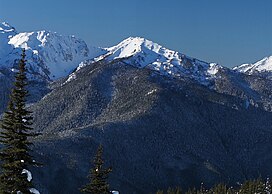geo.wikisort.org - Mountains
Mount Fitzhenry is a 6,050-foot (1,840-metre) mountain summit located within Olympic National Park in Clallam County of Washington state.[4] Mt. Fitzhenry is in the Bailey Range, which is a subrange of the Olympic Mountains. In clear weather, the mountain can be seen from the visitor center at Hurricane Ridge. Its nearest higher neighbor is Mount Fairchild, 1.57 mi (2.53 km) to the south.[1] Precipitation runoff from the mountain drains into tributaries of the Elwha River. Mount Fitzhenry is situated at the head of Fitzhenry Creek, and both are named for Edward Allen Fitzhenry (1868–1937), Clallam County surveyor from 1892-1900.[5] President Woodrow Wilson appointed Fitzhenry as Washington Surveyor General in 1913, and he later served as Deputy State Land Commissioner.[6]
| Mount Fitzhenry | |
|---|---|
 Mount Fitzhenry from Hurricane Ridge | |
| Highest point | |
| Elevation | 6,050 ft (1,840 m)[1] |
| Prominence | 450 ft (140 m)[1] |
| Parent peak | Mount Fairchild (6,925 ft)[2] |
| Isolation | 1.57 mi (2.53 km)[2] |
| Coordinates | 47°55′22″N 123°37′50″W[1] |
| Geography | |
| Location | Olympic National Park Clallam County, Washington, US |
| Parent range | Olympic Mountains |
| Topo map | USGS Mount Carrie |
| Geology | |
| Age of rock | Eocene |
| Climbing | |
| Easiest route | class 2 hiking[3] north ridge |
Climate
Based on the Köppen climate classification, Mount Fitzhenry is located in the marine west coast climate zone of western North America.[7] Most weather fronts originate in the Pacific Ocean, and travel northeast toward the Olympic Mountains. As fronts approach, they are forced upward by the peaks of the Olympic Range, causing them to drop their moisture in the form of rain or snowfall (Orographic lift). As a result, the Olympics experience high precipitation, especially during the winter months. During winter months, weather is usually cloudy, but, due to high pressure systems over the Pacific Ocean that intensify during summer months, there is often little or no cloud cover during the summer. In terms of favorable weather, the best months for viewing and climbing are July through September.
Geology
The Olympic Mountains are composed of obducted clastic wedge material and oceanic crust, primarily Eocene sandstone, turbidite, and basaltic oceanic crust.[8] The mountains were sculpted during the Pleistocene era by erosion and glaciers advancing and retreating multiple times.
Gallery
See also
- Olympic Mountains
- Geology of the Pacific Northwest
References
- "Mount Fitzhenry". Peakbagger.com.
- "Fitzhenry, Mount - 6,075' WA". listsofjohn.com. Retrieved 2020-06-13.
- climbersguideolympics.com Mount Fitzhenry
- "Mount Fitzhenry". Geographic Names Information System. United States Geological Survey, United States Department of the Interior. Retrieved 2020-06-14.
- Parratt, Smitty (1984). Gods and Goblins: A Field Guide to Place Names of Olympic National Park (1st ed.).
- https://www.olsonengr.com/download/globios/fitzhenryedwardabio2.pdf [bare URL PDF]
- Peel, M. C.; Finlayson, B. L.; McMahon, T. A. (2007). "Updated world map of the Köppen−Geiger climate classification" (PDF). Hydrol. Earth Syst. Sci. 11 (5): 1633–1644. Bibcode:2007HESS...11.1633P. doi:10.5194/hess-11-1633-2007. ISSN 1027-5606.
- Alt, D.D.; Hyndman, D.W. (1984). Roadside Geology of Washington. pp. 249–259. ISBN 0-87842-160-2.
External links
- "Olympic National Park". National Park Service.
- Mount Fitzhenry: weather forecast
- Edward A. Fitzhenry biography
Другой контент может иметь иную лицензию. Перед использованием материалов сайта WikiSort.org внимательно изучите правила лицензирования конкретных элементов наполнения сайта.
WikiSort.org - проект по пересортировке и дополнению контента Википедии


